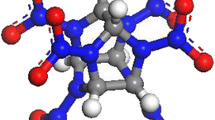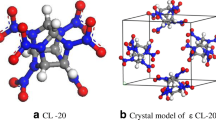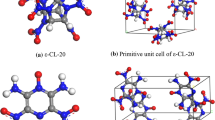Abstract
Multilayer-shaped compression and slide models were employed to investigate the complex sensitive mechanisms of cocrystal explosives in response to external mechanical stimuli. Here, density functional theory (DFT) calculations implementing the generalized gradient approximation (GGA) of Perdew-Burke-Ernzerhof (PBE) with the Tkatchenko-Scheffler (TS) dispersion correction were applied to a series of cocrystal explosives: diacetone diperoxide (DADP)/1,3,5-trichloro-2,4,6-trinitrobenzene (TCTNB), DADP/1,3,5-tribromo-2,4,6-trinitrobenzene (TBTNB) and DADP/1,3,5-triiodo-2,4,6-trinitrobenzene (TITNB). The results show that the GGA-PBE-TS method is suitable for calculating these cocrystal systems. Compression and slide models illustrate well the sensitive mechanism of layer-shaped cocrystals of DADP/TCTNB and DADP/TITNB, in accordance with the results from electrostatic potentials and free space per molecule in cocrystal lattice analyses. DADP/TCTNB and DADP/TBTNB prefer sliding along a diagonal direction on the a−c face and generating strong intermolecular repulsions, compared to DADP/TITNB, which slides parallel to the b−c face. The impact sensitivity of DADP/TBTNB is predicted to be the same as that of DADP/TCTNB, and the impact sensitivity of DADP/TBTNB may be slightly more insensitive than that of DADP and much more sensitive than that of TBTNB.

Theoretical insights into the sensitive mechanism of multilayer-shaped cocrystal explosives: compression and slide








Similar content being viewed by others
References
Bolton O, Matzger AJ (2011) Improved stability and smart-material functionality realized in an energetic cocrystal. Chem Int Ed 50:8960–8963
Yang Z-W, Li H-Z, Huang H, Zhou X-Q, Li J-S Nie F-D (2013) Preparation and performance of a HNIW/TNT cocrystal explosive. Propell Explos Pyrot 38:495–501
Bolton O, Simke LR, Pagoria PF, Matzger AJ (2012) High power explosive with good sensitivity: a 2:1 cocrystal of CL-20:HMX. Cryst Growth Des 12:4311–4314
Yang Z-W, Wang Y-P, Zhou J-H, Li H-Z, Huang H, Nie F-D (2014) Preparation and performance of a BTF/DNB cocrystal explosive. Propell Explos Pyrot 39:9–13
Wu J-T, Zhang J-G, Li T, Li Z-M, Zhang T-L (2015) A novel cocrystal explosive NTO/TZTN with good comprehensive properties. RSC Adv 5:28354–28359
Landenberger KB, Bolton O, Matzger AJ (2013) Two isostructural explosive cocrystals with significantly different thermodynamic stabilities. Angew Chem Int Ed 52:6468–6471
Landenberger KB, Bolton O, Matzger AJ (2015) Energetic-energetic cocrystals of diacetone diperoxide (DADP): dramatic and divergent sensitivity modifications via cocrystallization. J Am Chem Soc 137:5074–5079
Zhang H-B, Guo C-Y, Wang X-C, Xu J-J, He X, Liu Y, Liu X-F, Huang H, Sun J (2013) Five energetic cocrystals of BTF by intermolecular hydrogen bond and π-stacking interactions. Cryst Growth Des 13:679–687
Guo C-Y, Zhang H-B, Wang X-C, Liu X-F, Sun J (2013) Study on a novel energetic cocrystal of TNT/TNB. J Mater Sci 48:1351–1357
Yang Z-W, Li H-Z, Zhou X-Q, Zhang C-Y, Huang H, Li J-S, Nie F-D (2012) Characterization and properties of a novel energetic–energetic cocrystal explosive composed of HNIW and BTF. Cryst Growth Des 12:5155–5158
Shen J-P, Duan X-H, Luo Q-P, Zhou Y, Bao Q-L, Ma Y-J, Pei C-H (2011) Preparation and characterization of a novel cocrystal explosive. Cryst Growth Des 11:1759–1765
Massoni J, Saurel R, Baudin G, Demol GA (1999) Mechanistic model for shock initiation of solid explosives. Phys Fluids 11:710–736
Strom CB, Stine JR, Kramer JF (1990) Sensitivity relationships in energetic materials. In: Bulusu S (ed) Chemistry and physics of energetic materials.) Academic, New York, pp 979–984
Dong H-S, Zhou F-F (1994) High energetic explosives and relatives (in Chinese). Science Press, Beijing
Mathieu D (2012) Theoretical shock sensitivity index for explosives. J Phys Chem A 116:1794–1800
Ye S-J, Tonokura K, Koshi M (2003) Energy transfer rates and impact sensitivities of crystalline explosives. Combust Flame 132:240–246
Tan B-S, Long X-P, Peng R-F, Li H-B, Jin B, Chu S-J, Dong H-S (2010) Two important factors influencing shock sensitivity of nitro compounds: bond dissociation energy of X–NO2 (X = C, N, O) and mulliken charges of nitro group. J Hazard Mater 183:908–912
Li J-S (2010) A multivariate relationship for the impact sensitivities of energetic N-nitrocompounds based on bond dissociation energy. J Hazard Mater 174:728–733
Politzer P, Murray JS (1995) C–NO2 dissociation energies and surface electrostatic potential maxima in relation to the impact sensitivities of some nitroheterocyclic molecules. Mol Phys 86:251–255
Politzer P, Murray JS (1996) Relationships between dissociation energies and electrostatic potentials of C–NO2 bonds: applications to impact sensitivities. J Mol Struct 376:419–424
Murray JS, Lane P, Politzer P (1995) Relationships between impact sensitivities and molecular surface electrostatic potentials of nitroaromatic and nitroheterocyclic molecules. Mol Phys 85:1–8
Murray JS, Lane P, Politzer P (1998) Effects of strongly electron-attracting components on molecular surface electrostatic potentials: application to predicting impact sensitivities of energetic molecules. Mol Phys 93:187–194
Owens FJ, Jayasuriya K, Abrahmsen L, Politzer P (1985) Computational analysis of some properties associated with the nitro groups in polynitroaromatic molecules. Chem Phys Lett 116:434–438
Murray JS, Lane P, Politzer P, Bolduc PR (1990) A relationship between impact sensitivity and the electrostatic potentials at the midpoints of C–NO2 bonds in nitroaromatics. Chem Phys Lett 168:135–139
Rice BM, Hare JJ (2002) A quantum mechanical investigation of the relation between impact sensitivity and the charge distribution in energetic molecules. J Phys Chem A 106:1770–1783
Murray JS, Concha MC, Politzer P (2009) Links between surface electrostatic potentials of energetic molecules, impact sensitivities and C–NO2/N–NO2 bond dissociation energies. Mol Phys 107:89–97
Liu Y, Wang L-J, Wang G-X, Du H-C Gong X-D (2012) Theoretical studies on 2-diazo-4,6-dinitrophenol derivatives aimed at finding superior propellants. J Mol Model 18:1561–1572
Politzer P, Murray JS (2015) Some molecular/crystalline factors that affect the sensitivities of energetic materials: molecular surface electrostatic potentials, lattice free space and maximum, heat of detonation per unit volume. J Mol Model 21:25–35
Politzer P, Murray JS (2015) Impact sensitivity and the maximum heat of detonation. J Mol Model 21:262–272
Zhang C-Y (2007) Investigation of the slide of the single layer of the 1,3,5-triamino-2,4,6-trinitrobenzene crystal: sliding potential and orientation. J Phys Chem B 111:14295–14298
Zhang C-Y, Wang X-C, Huang H (2008) π-stacked interactions in explosive crystals: buffers against external mechanical stimuli. J Am Chem Soc 130:8359–8365
Kamlet MJ, Adolph HG (1979) The relationship of impact sensitivity with structure of organic high explosives. II. polynitroaromatic explosives. Propell Explos Pyrot 4:30–34
Zhang C-Y, Shu Y-J, Huang Y-G Zhao X-D, Dong H-S (2005) Investigation of correlation between impact sensitivities and nitro group charges in nitro compounds. J Phys Chem B 109:8978–8982
McNesby KL, Coffey CS (1997) Spectroscopic determination of impact sensitivities of explosives. J Phys Chem B 101:3097–3104
Ma Y, Zhang A-B, Zhang C-H, Jiang D-J, Zhu Y-Q, Zhang C-Y (2014) Crystal packing of low-sensitivity and high-energy explosives. Cryst Growth Des 14:4703–4713
Zhang C-Y (2006) Investigation on the correlation between the interaction energies of all substituted groups and the molecular stabilities of nitro compounds. J Phys Chem A 110:14029–14035
Du S, Wang Y, Chen L-Z, Shi W-J, Ren F-D, Li Y-X, Wang J-L, Cao D-L (2012) A B3LYP and MP2(full) theoretical investigation into explosive sensitivity upon the formation of the molecule-cation interaction between the nitro group of 3,4-dinitropyrazole and H+, Li+, Na+, Be2+ or Mg2+. J Mol Model 18:2105–2115
Pospíšil M, Vávra P, Concha MC, Murray JS, Politzer P (2010) A possible crystal volume factor in the impact sensitivities of some energetic compounds. J Mol Model 16:895–901
Wang Q, Ma H-X, Li J-Z, Wei H-J, Fan X-Z (2012) Theoretical studies on the relationships between molecular structure or thermodecomposition parameters and impact sensitivity of azotetrazolate nonmetallic salts. Acta Chim Sin 70:629–634
Chen G, Shi W-Y, Xia M-Z, Lei W, Wang F-Y, Gong X-D (2014) Theoretical study of solvent effects on RDX crystal quality and sensitivity using an implicit solvation model. J Mol Model 20:2326–2327
Lin H, Zhu S-G, Li H-Z, Peng X-H (2013) Structure and detonation performance of a novel HMX/LLM-105 cocrystal explosive. J Phys Org Chem 26:898–907
Wei C-X, Huang H, Duan X-H, Pei C-H (2011) Structure and properties prediction of HMX/TATB cocrystal. Propellants Explos Pyrotech 36:416–423
Lin H, Zhu S-G, Zhang L, Peng X-H, Li H-Z (2013) Synthesis and first principles investigation of HMX/NMP cocrystal explosive. J Energ Mater 31:261–272
Li H-R, Shu Y-J, Gao S-J, Chen L, Ma Q, Ju X-H (2013) Easy methods to study the smart energetic TNT/CL-20 co-crystal. J Mol Model 19:4909–4917
Guo D-Z, An Q, Goddard WA, Zybin SV, Huang FL (2014) Compressive shear reactive molecular dynamics studies indicating that cocrystals of TNT/CL-20 decrease sensitivity. J Phys Chem C 118:30202–30208
Binns J, Healy MR, Morrison CA (2014) Assessing the performance of density functional theory in optimizing molecular crystal structure parameters. Acta Crystallogr, Sect B: Struct Sci 70:259–267
Delley B (1990) An all-electron numerical method for solving the local density functional for polyatomic molecules. J Chem Phys 92:508–517
Delley B (2000) From molecules to solids with the DMol3 approach. J Chem Phys 113:7756–7764
Perdew JP, Burke K, Ernzerhof M (1996) Generalized gradient approximation made simple. Phys Rev Lett 77:3865–3868
Perdew JP, Wang Y (1992) Accurate and simple analytic representation of the electron-gas correlation energy. Phys Rev B 45:13244–13249
Perdew JP, Chevary JA, Vosko SH, Jackson KA, Pederson MR, Singh DJ, Fiolhais C (1992) Atoms, molecules, solids, and surfaces: applications of the generalized gradient approximation for exchange and correlation. Phys Rev B 46:6671–6687
Tkatchenko A, Scheffler M (2009) Accurate molecular van der Waals interactions from ground-state electron density and free-atom reference data. Phys Rev Lett 102:073005
Dubnikova F, Kosloff R, Almog J, Zeiri Y, Boese R, Itzhaky H, Alt A, Keinan E (2005) Decomposition of triacetone triperoxide is an entropic explosion. J Am Chem Soc 127:1146–1159
Gerard F, Hardy A, Becuwe A (1993) Structure of 1,3,5-trichloro-2,4,6-trinitrobenzene. Acta Crystallogr, Sect C: Cryst Struct Commun 49:1215–1218
Lu T, Chen F (2012) Multiwfn: a multifunctional wavefunction analyzer. J Comput Chem 33:580–592
Lu T, Chen F (2012) Quantitative analysis of molecular surface based on improved Marching Tetrahedra algorithm. J Mol Graph Model 38:314–323
Zhang C-Y (2007) Computational investigation on the desensitizing mechanism of graphite in explosives versus mechanical stimuli: compression and glide. J Phys Chem B 111:6208–6213
Thanthiriwatte KS, Hohenstein EG, Burns LA, Sherrill CD (2011) J Chem Theory Comput 7:88–96
Arunan E, Desiraju GR, Klein RA, Sadlej J, Scheiner S, Alkorta I, Clary DC, Crabtree RH, Dannenberg JJ, Hobza P, Kjaergaard HG, Legon AC, Mennucci B, Nesbitt DT (2011) Definition of the hydrogen bond (IUPAC recommendations 2011). Pure Appl Chem 83:1637–1641
Pospišil M, Vávra P, Concha MC, Murray JS, Politzer P (2011) Sensitivity and the available free space per molecule in the unit cell. J Mol Model 17:2569–2574
Politzer P, Murray JS (2014) Impact sensitivity and crystal lattice compressibility/free space. J Mol Model 20(2223):1–8
Armstrong RW, Ammon HL, Elban WL, Tsai DH (2002) Investigation of hot spot characteristics in energetic crystals. Thermochim Acta 384:303–313
Mark BB (1990) A thermochemical model for shock-induced reactions (heat detonations) in solids. J Chem Phys 92:1839–1848
Dick JJ (1984) Effect of crystal orientation on shock initiation sensitivity of pentaerythritol tetranitrate explosive. Appl Phys Lett 44:859–861
Yoo CS, Holmes NC, Souers PC, Wu C-J, Ree FH, Dick JJ (2000) Anisotropic shock sensitivity and detonation temperature of pentaerythritol tetranitrate single crystal. J Appl Phys 88:70–75
Plaskin I, Coffey CS, Mendes R, Ribeiro J, Campos J, Direito J (2006) 13th Symposium (International) on Detonation, ONR 351-07-01. Office of Naval Research, Arlington, VA, p 319
Dang NC, Dreger ZA, Gupta YM, Hooks DE (2010) Time-resolved spectroscopic measurements of shock-wave induced decomposition in cyclotrimethylene trinitramine (RDX) crystals: anisotropic response. J Phys Chem A 114:11560–11566
Acknowledgment
We gratefully acknowledge the National Key Laboratory of Applied Physics and Chemistry for financial support.
Author information
Authors and Affiliations
Corresponding author
Electronic supplementary material
Below is the link to the electronic supplementary material.
ESM 1
(DOCX 1108 kb)
Rights and permissions
About this article
Cite this article
Gao, Hf., Zhang, Sh., Ren, Fd. et al. Theoretical insight into the sensitive mechanism of multilayer-shaped cocrystal explosives: compression and slide. J Mol Model 22, 108 (2016). https://doi.org/10.1007/s00894-016-2973-5
Received:
Accepted:
Published:
DOI: https://doi.org/10.1007/s00894-016-2973-5




